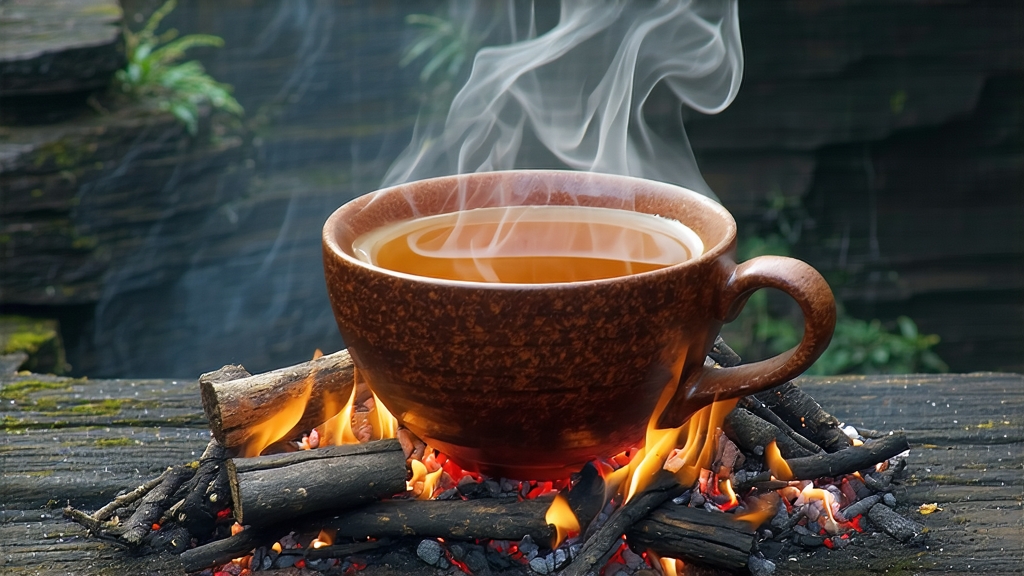
Long before English breakfast blends and afternoon tea services, there was Lapsang Souchong—an assertive, pine-smoked black tea that sprang from the mist-wrapped Wuyi Mountains of northern Fujian. International drinkers often meet it as a curiosity, yet this leaf is the primogenitor of every black tea on earth. In the early seventeenth century, when green tea still dominated Chinese export, Wuyi farmers discovered that allowing fresh leaves to oxidize fully before firing produced a copper-red liquor that traveled better than any green. European merchants christened the new category “bohea,” a corruption of “Wuyi,” and Lapsang Souchong—literally “small plant from the original mountain”—became the first intentionally smoked black tea, the prototype that launched a global obsession.
History: Smoke as Preservation and Signature
Legend places the birth of smoking in 1646, when Qing troops galloped through Tongmu village and forced tea makers to speed-dry their harvest. Wood-rich pine was fed into hastily built ovens; the leaves absorbed the resinous aroma and, against all odds, arrived in London fragrant, intact, and irresistible. Whether myth or marketing, the technique endured. By 1669 the British East India Company listed “Lapsang” among its most valuable cargoes, priced above silver. The tea rode clippers around the Cape of Good Hope, perfumed the salons of Paris, and inspired Earl Charles Grey to add bergamot to a similar China-black base, creating the eponymous blend. Thus, the flavor that began as accident became identity: pine smoke equals authenticity.
Terroir and Cultivars
Tongmu Guan, a protected enclave inside the Wuyi National Nature Reserve, sits at 27° N latitude where subtropical humidity collides with mineral-rich granite soils. Day-night temperature swings of 15 °C slow leaf growth, concentrating sugars and volatile oils. Only six native cultivars are permitted under the geographical indication: Xiao Zhong (small leaf), Ye Bei (wild north), and four clonal selections known collectively as Wuyi Qizhong. Spring picking begins when the mountain azaleas bloom, usually between Qingming and Guyu—two solar terms that fall in early to mid-April. One kilogram of finished Souchong requires roughly fifty thousand buds and the youngest two leaves, all plucked before 10 a.m. while dew still glistens.
Craft: Four Centuries of Nuanced Fire
Traditional processing unfolds over twenty-four hours and remains almost entirely manual. Withering happens in the second story of wooden barns where pine smoke from ground-floor ovens drifts upward through slatted bamboo racks. Artisans shuffle leaves every twenty minutes for eight hours, coaxing moisture down to 60 %. Rolling follows, but unlike the brutal maceration applied to Assam teas, Tongmu craftsmen use a light kneading motion that preserves bud integrity. Oxidation occurs in deep bamboo baskets lined with wet cotton; the humid mountain air turns the leaf a mahogany brown within three hours. The critical stage is smoking-hot finishing: fresh resinous pine logs are ignited, then smothered to create a cool, aromatic smolder (28–32 °C). Tea masters spread the oxidized leaf on sieves suspended 1.5 m above the embers, allowing smoke to kiss—not cook—the tea for six to eight hours. A final charcoal bake at 80 °C drives residual moisture to 4 % and crystallizes the signature tarry sweetness. The best lots rest one month in fired-clay jars so smoke and leaf marry; mass-market versions may be flash-smoked in rotating drums for minutes, not hours, explaining the acrid aftertaste that gives Lapsang a polarized reputation.
Grades: From Imperial Needle to Russian Caravan
Within Tongmu, three grades are recognized. Zheng Shan Xiao Zhong—often sold simply as “unsmoked”—is dried over glowing charcoal without fresh pine, yielding a honeyed cocoa cup favored in Shanghai and Tokyo. Traditional Lapsang Souchong receives the full pine treatment yet keeps its strip shape intact; the highest grade, Junmei (golden eyebrow), incorporates only buds, producing a downy, shimmering leaf and a syrupy liquor reminiscent of longan and pipe tobacco. Outside the reserve, neighboring counties produce Wuyi Smoked Black, a bolder, coarser leaf marketed as “Russian Caravan” to evoke trans-S